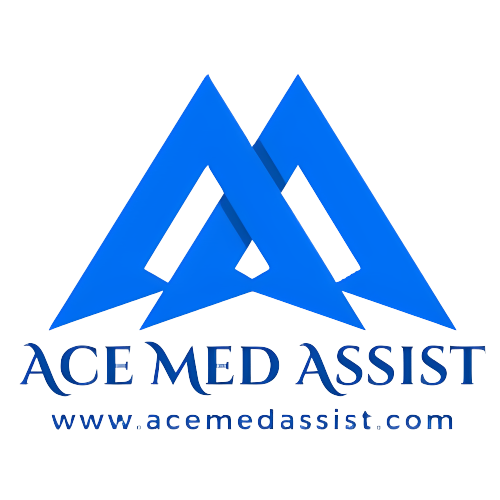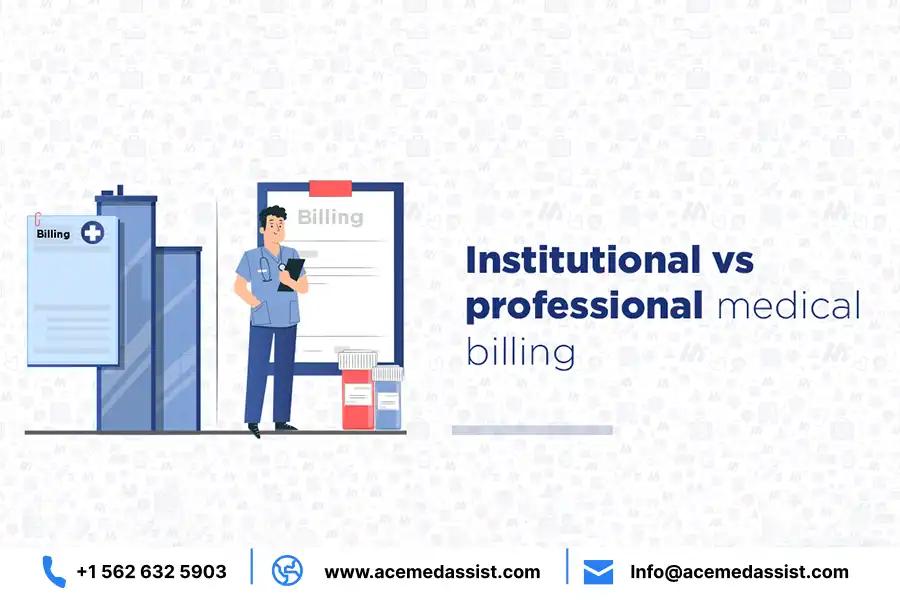Medical billing procedures guarantee that hospitals and healthcare professionals get compensated for their services. It’s becoming more and more crucial to comprehend the main distinctions between institutional and professional billing as the healthcare sector develops. In actuality, professional and institutional billing operate very differently even if they have the same general objective.
Medical billing as opposed to institutional billing. Professional billing is for healthcare practitioners; institutional billing is for services rendered in hospitals or clinics. Professional billing takes care of healthcare provider fees; institutional billing covers facility costs.
This article describes the many forms of billing and the reasons that revenue management requires accuracy. We’ll go over typical problems, recommended procedures, and upcoming developments that billing professionals should be aware of.
Basics of Medical Billing:

Let’s quickly review the fundamentals of medical billing before moving on to professional and institutional billing.
Meaning of Medical Billing
According to AAPC, medical billing is the process by which healthcare practitioners file claims with insurance companies to get reimbursed for services provided. A step in the procedure is gathering patient data. The process also includes coding diagnoses and procedures. Insurance verification is also required.
There is one more stage in the process: submitting claims. Investigating unpaid claims is vital. Last but not least, the procedure includes appealing claims that are denied.
Important Elements of Medical Billing:

Medical billing services in US differ in many ways, however, they all depend on the same essential elements:
Details about the patient
Precise patient data is essential for medical billing. Name, date of birth, residence, insurance information, and other facts are included.
Codes for Diagnoses and Procedures
When entering diagnoses and treatments in medical records, doctors utilize certain codes. Along with claims, insurance companies receive this coding data.
Verification of Insurance
To ensure that the patient’s insurance pays for the services rendered, the billing team must verify this. Its purpose is to ascertain the patient’s financial obligation.
Institution Billing:

Healthcare facilities such as clinics, hospitals, assisted living facilities, surgical centres, and the like are covered under institutional billing. It covers the services rendered during a hospital stay or follow-up visit to a medical facility.
Essentially, institutional billing entails:
Clinics, Hospitals, and Medical Facilities
Individual services can be rendered by clinical staff members, but institutional billing is centered around a hospital, clinic, or another facility.
Services That Institutional Billing Covers
Hospital services are included in institutional billing. These services may include both treatments and admissions. They also pay for supplies, medications, and lodging costs. Institutional billing also includes emergency and outpatient services that a facility offers.
The Billing Procedure
Generally, institutional billing proceeds as follows:
UB-04 documents
How to enter institutional services on UB claim forms is explained by the National Uniform Billing Committee. The UB-04 form is used by nearly all institutional providers.
Codes of Revenue
To classify costs for billing, the billing process assigns codes to goods and services for patients.
Professional Billing:

Professional billing is used by physicians, nurses, therapists, chiropractors, and other medical professionals to bill for their services. It covers healthcare provided outside of hospitals, such as in-home or private medical services.
Professional billing is distinguished by two attributes:
Doctors and Other Healthcare Professionals
Professional billing is used by private healthcare providers rather than hospitals or extended care institutions. It consists of medical professionals such as nurses, therapists, home health aides, and physicians.
Services Covered Types
Outside the hospital services are included in professional billing. Office visits, consultations, x-rays, physical therapy, home health, preventative care, and speciality treatments are just a few possible options.
The Billing Procedure
Medical coding is used in the billing process, which typically consists of these phases.
Meet Forms
Forms such as the Superbill or Encounter Sheet are used by medical professionals to document patient visits. These forms collect vital data such as services, diagnostic specifics, and demographics.
Superbills
The data from the form is sent to the Superbill during the billing process. The Superbill has all the information required for invoicing.
Differences Between Professional and Institutional Billing:

Within the same environment, professional and institutional billing in healthcare differ fundamentally. Among them are
Billing Entities
The submitting provider differs greatly throughout invoicing kinds, as previously mentioned:
Healthcare institutions vs lone practitioners
Clinical providers are the source of professional billing, whereas hospitals or clinics are the source of institutional billing.
Services Types:
The forms of billing also vary according to the services rendered:
Inpatient vs. outpatient medical care
The focus of professional billing is on ambulatory and outpatient services. Inpatient, emergency, hospital-based outpatient, and additional facility services are all included in institutional billing.
Certain methods
Numerous specialized medical procedures, including heart catheterizations, endoscopies, operations, therapy sessions, and complicated imaging, are billed by institutional rules. Exams, minor treatments, and routine outpatient consultations are usually billed by professionals.
Obstacles and Optimal Methods in Medical Billing

Accurate professional and institutional billing is certainly not simple, despite its importance. There are some difficulties that medical billing companies might face,
Typical Obstacles in Professional Billing
Staffing shortages, payer shifts, complicated coding, denied claims and patient accountability are some of the difficulties faced by billing teams.
Typical Issues with Institutional Billing
Confusion over revenue codes, challenging software, Medicare rejections, resource constraints, and problems with system consolidation are examples of institutional obstacles.
The Best Methods for Resolving Billing Issues
The most effective methods for resolving billing issues entail a thorough strategy. It integrates cutting-edge technology, enhanced front-end workflows, expert billing services, and payer relationships as a top priority. Healthcare companies may enhance their financial performance by minimizing mistakes and denials, streamlining their billing processes, and optimizing their billing operations.
Future Trends in Medical Billing

Medical billing is a profession that is changing in tandem with healthcare. The future of medical billing is being shaped by new technology, evolving healthcare regulations, and intricate medical procedures.
Technological Progress
Because of the innovations that new technology brings, billing departments will see a major improvement in their operations. One major area where innovation will have a big influence is automation. With the use of sophisticated software and systems, billing operations may be made simpler and more efficient, increasing their effectiveness. Instead of performing things by hand, people may now do them automatically, saving time and minimizing errors.
Artificial Intelligence Integration
Artificial intelligence, or AI, benefits billing teams by offering helpful support for many aspects of their job. This AI examine data to identify inaccuracies in billing records, guaranteeing precise transaction billing and recordkeeping. AI also has the potential to greatly increase billing teams’ revenue. AI can identify trends in customer behaviour by using analytics, machine learning, and data mining. It helps billing teams find ways to increase product sales and enhance pricing tactics.
Regulations Changing That Affect Billing Procedures
The way insurance companies pay for medical treatments is altered by payer policies. Modifications to coverage, payment schedules, and paperwork requirements are just a few examples of the policies that may be included. Healthcare providers must keep informed about changes in payer policy and modify their billing procedures accordingly to guarantee appropriate payment.









